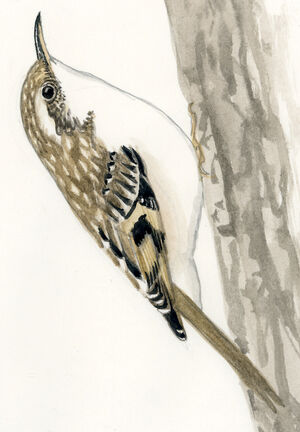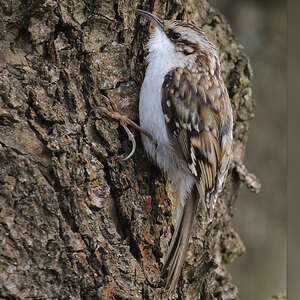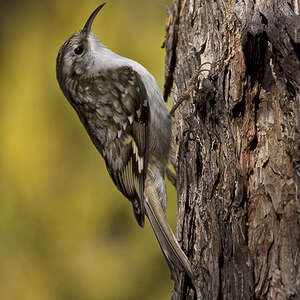Eurasian Treecreeper
Certhia familiaris - Grimpereau des bois
Identification
Small birds known as Treecreepers are specially adapted to living in trees, more specifically in the bark of trees. They move up and down like woodpeckers, using their tail as a stabilizer. Their upper parts are usually a mottled brown colour, a mixture of tan and dark brown, which makes them almost disappear in the bark like camouflage. In Europe, two closely related species live in the same area, the Eurasian Treecreeper and the Short-toed Treecreeper. They are very similar in looks and identification can be tricky. The best method of identification is by voice (see next chapter). The colour of their flanks is also a way to differentiate between the species. The Eurasian Treecreeper will usually have white flanks washed with rust while the Short-toed Treecreeper's flanks are darker, a mix of brown and grey. Other harder to spot characteristics are the bill length and the toe-claw in relation to the digit ratio; In the Eurasian Treecreeper, the bill is considered short while the claw is longer than the foot it is on. In the Short-toed Treecreeper, it is the other way around; the bill is longer and the claw is about the same size as the digit it is attached to. There are also many wing characteristics that, when seen on illustrated pictures, can be used to identify the species, such as the blackish alula, the cream colour of the remiges, and the shape primary projection. Going into details on all the subtle differences here would be tedious and probably confusing; the best course of action is to look at the pictures in the galery and make comparisons.
Subspecific information 10 subspecies
- Certhia familiaris familiaris (n and e Europe)
- Certhia familiaris britannica ()
- Certhia familiaris macrodactyla (w and c Europe)
- Certhia familiaris corsa (Corsica)
- Certhia familiaris daurica (s Siberia and n Kazakhstan to se Siberia, n Japan, Korea and ne China)
- Certhia familiaris caucasica (n Turkey through the Caucasus)
- Certhia familiaris persica (se Azerbaijan and n Iran)
- Certhia familiaris bianchii (n and c China)
- Certhia familiaris tianschanica (se Kazakhstan, Kyrgyzstan and nw China)
- Certhia familiaris japonica (s Japan)
Foreign names
- Grimpereau des bois,
- Agateador euroasiático,
- trepadeira-do-norte,
- Waldbaumläufer,
- hegyi fakusz,
- Taigaboomkruiper,
- Rampichino alpestre,
- trädkrypare,
- Trekryper,
- kôrovník dlhoprstý,
- šoupálek dlouhoprstý,
- Træløber,
- puukiipijä,
- raspinell pirinenc,
- Skógfeti,
- pełzacz leśny,
- mizložņa,
- dolgoprsti plezalček,
- Пищуха,
- キバシリ,
- 旋木雀,
- trädkrypare,
- 旋木雀,
Voice song and call
The vocalization is the best discriminative criterion between the two Treecreepers. The song is a quick succession of sharp, whistled and penetrating notes, ending with a staccato crescendo. The phrase might end with an interrogative Tui. Very distinct from that of the Eurasian Treecreeper, it lasts 2 to 3 seconds.
The usual call is a high-pitched long siiiiiiiiih, often repeated. Sometimes one can hear a vibrating sriiiiiiiih. It might recall a Goldcrest call, but it is sharper. It is also possible to hear contact calls between individuals which are quite similar to those of the Eurasian Treecreeper.
In a sympatric situation, the singing might evolve and the initial part of the phrase sounds like that from the Eurasian Treecreeper, probably for the purpose of reciprocal territorial exclusion. This can be confusing and one should pay attention to all vocalizations.
Habitat
West of its range, in France for example, the Eurasian Treecreeper is clearly a mountain species, being regular above 1000m altitude.
In the south of its range, it is at higher altitudes due to the latitude, up to 1500m in the south of Europe, 3000m in the Caucasus, and from 1000 to 4200m in the Himalayan chain where it comes into contact with its local congener, the Himalayan Treecreeper.
Behaviour character trait
Eurasian Treecreepers look like small woodpeckers that climb up trunks and branches using their sharp claws and long stiff tail.
They climb in small hops, taking regular support from their tail.Treecreepers are usually solitary birds outside of the breeding season, due to their biology. Searching for food on the bark takes up all of their time, and they don't tolerate competition. However, in winter they sometimes join a flock of tits, especially for protection.
These birds are sedentary over most of their range. It is amazing to see such small birds making it through sometimes harsh winter conditions. This highlights the availability of an unseen food resource that they can locate with their eyes.
Flight
Dietfeeding habits
The Eurasian Treecreepers search for their food on trunks and branches, meticulously inspecting the bark and epiphytes - mosses, lichens and higher plants - for invertebrates and their forms of resistance, and doing this throughout the seasons since they are mostly sedentary.
Their thin, hooked beaks are not made for working the bark, only for slipping into crevices in search of prey. These prey are mainly insects and spiders, as well as the forms of resistance of the first, eggs, larvae and chrysalides.
Reproduction nesting
The Eurasian Treecreeper is monogamous and territorial. Depending on the latitude, he raises one or two broods per year from April to July.
Unlike his relative who likes to build his nest under a peeled bark, he prefers to nest in a crack resulting from the wood splitting due to a gust of wind, often in a candle, at a respectable height. If necessary, any confined space in the wood can do.He builds his tight nest mostly with piled twigs with a central cut lined with soft elements such as feathers. The female lays her 5-6 white eggs lightly speckled with light brown in a crown at the big end. The female incubates alone for about 2 weeks. The couple feeds the young at the nest for 15 to 20 days, with the male having the main role at the beginning of the breeding. After the takeoff, each parent takes charge of part of the brood to the point of losing contact.
Geographic range
The breeding range of the Eurasian Treecreeper is very wide, extending continuously throughout temperate and boreal Eurasia. The Scandinavian peninsula, British Isles and France mark the western edge, with Sakhalin, the Japanese archipelago and the Korean peninsula at the east. Further south, the species is found at higher altitudes in Italy and Greece, the Caucasus region and the Tibetan Plateau. Birds from the northern parts of the range can be subject to seasonal movements during the winter.
Threats - protection
IUCN conservation status
concern
in the Wild
threatened
evaluated
The species is not globally threatened due to its huge distribution range. It could become so, especially in the south, due to current climate changes which cause a rapid global warming and strong summer droughts. For a cold bird, this could be disastrous.
Sources of information
- IOC World Bird List (v15.1), Gill, F and D Donsker (Eds). 2025-12-07.
- Les passereaux d'Europe, tome 2, P. Géroudet, M. Cuisin
- Birds of the World, The Cornell Lab of Ornithology
- xeno-canto, Sharing bird sounds from around the world,
Other sources of interest
 Specification sheet created on
23/07/2023 by Jean François
Specification sheet created on
23/07/2023 by Jean FrançoisTranslation by AI Oiseaux.net
© 1996-2026 Oiseaux.net
- Accipitriformes
- Aegotheliformes
- Anseriformes
- Apodiformes
- Apterygiformes
- Bucerotiformes
- Caprimulgiformes
- Cariamiformes
- Casuariiformes
- Charadriiformes
- Ciconiiformes
- Coliiformes
- Columbiformes
- Coraciiformes
- Cuculiformes
- Eurypygiformes
- Falconiformes
- Galliformes
- Gaviiformes
- Gruiformes
- Leptosomiformes
- Mesitornithiformes
- Musophagiformes
- Nyctibiiformes
- Opisthocomiformes
- Otidiformes
- Passeriformes
- Pelecaniformes
- Phaethontiformes
- Phoenicopteriformes
- Piciformes
- Podargiformes
- Podicipediformes
- Procellariiformes
- Psittaciformes
- Pterocliformes
- Rheiformes
- Sphenisciformes
- Steatornithiformes
- Strigiformes
- Struthioniformes
- Suliformes
- Tinamiformes
- Trogoniformes


































